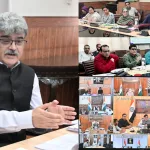A few months before my father passed away, he called me one day and said he wanted to speak about something important. I tried to avoid the conversation, it felt uncomfortable, almost unbearable, but he was gentle yet firm. With calmness in his voice and not a trace of fear, he asked me to sit beside him and listen. He began to explain the sacred bond I share with him, with his father and grandfather, and with the long chain of ancestors who came before us. “Just as you are connected to me,” he said, “you will pass on this bond to your son, and he to his children, and so on.”
He then carefully recited the names of our ancestors, reaching back four or five generations, and wrote out by hand the mantra that I should chant every morning while offering tarpana to him after his passing. He even included the names of those from my mother’s side and other relatives who had departed, reminding me that they too lived within our bloodline and memory.
Before we ended, he instructed me with clarity: in the first year after his death, I must perform every Shradha without fail. Summoning my courage, I asked him, “But how will I speak to you when you are no longer here?” He looked at me with quiet assurance and replied with words that still echo within me:“You don’t need my body to speak with me.”Since his passing away, I performed all the rituals as per his instructions and make sure I offer tarpan every morning, irrespective of where I am. What once felt like a difficult duty has now become a living reminder of his wisdom, that our connection with those who came before us transcends the body.
It is in this spirit that, every year during Pitṛ Pakṣa, countless families across India come together to perform Shradha, rituals of remembrance for their ancestors. It is a sincere yet intimate time when lamps are lit, food and water are offered and prayers are carried into the unseen realms. For the devout, these acts are not mere customs but sacred duties, expressions of reverence toward those who are no longer present in physical form yet continue to live through us. Shradha becomes an act of gratitude, acknowledging the unbroken chain of life that has shaped who we are. It is a way of silently saying, “I am because you were.”
This practice is not also just about feeding the departed, it is about nourishing memory, humility and continuity. When a child watches her parents offer food to ancestors she has never met, she learns, perhaps unconsciously, that life is not an isolated journey but part of a larger story. In this way, Shradha does more than honour the past, it shapes the psychological and cultural fabric of generations, instilling values of indebtedness, thankfulness and belonging.
And yet, in an age dominated by science and rationality, questions naturally arise. Does the food offered and water poured in rituals really reach our ancestors? Are these offerings merely symbolic gestures of respect, or do they hold a hidden efficacy beyond the physical eye? Some even go further, dismissing Shradha as an outdated practice, a clever invention by priests to secure food and alms.
Recently, I had a conversation with some young millennials, during a family gathering. One of the youngsters said that, “Wouldn’t it be better if we gave this food to an NGO or feed hungry children in a shelter, instead of offering it to crows?”. I felt that he was echoing a sentiment shared by many who feel such rituals no longer sync with modern values. These doubts are not new.
Generations before us have wrestled with them, some dismissing Shradha as superstition, others holding onto it as sacred obligation. The tension lies in whether we see rituals as empty tradition or as carriers of deeper truths, truths about continuity, consciousness and connection that perhaps both ancient wisdom and modern science are only beginning to illuminate.
For this, first we need to understand the striking differences between Bharat’s civilizational thought and that of the Abrahamic West, and their understanding of life, death and continuity. In the traditions of Judaism, Christianity and Islam, the soul is believed to rest in the grave after death, awaiting judgment and eternal placement in heaven or hell. There is no concept of rebirth or cyclic existence.
This worldview inevitably fosters a linear, one-life outlook, where fulfilment must be sought here and now. When the spiritual horizon is limited to a single lifetime, indulgence in worldly pleasure becomes natural, even logical. The modern Western consumerist philosophy, often summed up as “You Only Live Once (YOLO)” or the fear-driven “Fear of Missing Out (FOMO)”, is a direct cultural extension of this worldview.
By contrast, Indic civilization, nurtured by Sanatana Dharma, offers a radically different vision. Rooted in the doctrines of karma and punarjanma (rebirth), life is seen not as a fleeting one-time opportunity, but as part of an unbroken continuum of consciousness. Every action is a seed, carrying consequences into future births, shaping the journey of the soul. This cyclical worldview naturally emphasizes dharma (duty), restraint, gratitude and liberation (moksha) over unchecked consumption.
India also produced materialist schools such as Charvak, which argued that one should “eat, drink, and live” without concern for afterlife, however it remained a marginal strand of thought, never the civilizational core. Today’s YOLO and FOMO cultures echo Charvak’s pleasure-seeking, but unlike in the West, Bhartiya civilization historically placed such ideas on the periphery while holding dharma, self-realization and reverence for ancestors at the centre.
Unfortunately, when invaders and colonial powers entered Bharat, they came not merely with armies but with narratives designed to undermine this civilizational confidence. For centuries, European colonizers branded India’s traditions as orthodox, asabhya (uncultured), and regressive. Rituals like Shradha, deeply tied to the Indic worldview of continuity, were mocked as primitive superstitions.
This was part of what Rudyard Kipling infamously termed the “White Man’s Burden”, the colonial justification that it was the duty of Europeans to “civilize” India. Under this pretext, colonials dismissed Bhartiya rituals, philosophies and cultural practices as barbaric, while presenting Western values as universal and superior. The outcome was a psychological colonization, where generations of Indians began to view their own heritage through the distorted lens of Western judgment.
Yet, beneath these colonial labels lies a civilizational truth. Bharat’s worldview is not a burden but a gift to humanity, a philosophy that situates man within an eternal continuum of existence, balances material and spiritual life and insists that liberation lies not in indulgence but in transcendence.
One of the profound streams of such Bhartiya thought lies in Kashmir Shaivism, which believes that the entire universe is the manifestation of a single Consciousness—Chit or Paramshiva. Nothing exists outside this field of awareness; every being, every element, every thought is but a vibration (spanda) of that infinite Consciousness. Within this vision, there is no real separation between the living and the departed. The physical body dissolves into the five elements (air, water, ether, fire, earth), but the subtle impressions (saṁskars) of a being remain embedded in the universal field of Consciousness.
Death, therefore, is not extinction but a reconfiguration of tattvas (principles of existence), a shift of form within the continuum of the same reality. Even the Advaitavada echoes this insight. The Upaniṣhadic proclamation “Aham Bramasmi”—this Self is Brahman—reminds us that the individual self is not separate from the cosmic self. Just as a wave is never apart from the ocean, so too are ancestors and descendants never apart from the same undivided Consciousness.
In this framework, rituals like Shradha acquire a much deeper meaning. When we offer water (tarpana) or food (piṇḍa), the act is not a mere physical transaction. It is an offering made in the awareness of oneness, a conscious expression of gratitude that carries vibrations across subtle planes. The Shradha, the devotion, the intent behind the act, becomes the true medium of connection.
Thus, Shradha is not superstition, nor is it confined to symbolic gesture. It is the practical application of Advaita and Shaiva philosophy, where we acknowledge that the chain of existence, past, present and future, is woven in the same fabric of Consciousness. Through Shradha, we do not merely honour our ancestors; we reaffirm our own place in the eternal rhythm of Shiva.
In the contemporary world, the Modern science, in its quest to probe the hidden layers of reality, has uncovered truths that resonate deeply with Bhartiya spiritual traditions. The famous Alain Aspect experiment (1981) in France and later Chinese teleportation experiments (2017) on quantum entanglement revealed that once two particles are connected, they remain mysteriously linked, influencing each other instantly across vast distances.
This discovery reflects the Indian insight that we remain forever entangled with our ancestors, not just biologically through DNA, but also psychologically through memory and spiritually through the boundless field of Consciousness. What this shows is radical thought that once connected, entities cannot be fully separated. They remain bound in a non-local field beyond time and space. Thus, when we perform Shradha, offering water (tarpana) or food (piṇḍa), the act is less about material transfer and more about sending vibrations of gratitude through this invisible, non-local field.
Another important experiment conducted in science by Thomas Young is double-slit experiment that further showed that particles behave differently when observed, collapsing from waves of infinite possibility into fixed outcomes. This observer effect demonstrates that conscious attention alters reality. Ancient seers anticipated this truth when they emphasized that it is not the external ritual itself that holds the power, but the Shradha, the heartfelt intent and awareness behind it, that transforms the act into a living connection with subtle realms.
In the science of epigenetics, an experiment conducted by Emory University, it has also been proven that memories and impressions are biologically inherited across generations, an echo of our philosophical understanding of samskars. Through Shradha, we are not only reaching ancestors in unseen dimensions but also healing the ancestral memory imprinted within ourselves, harmonizing the living chain of existence.
There are also many experiments and studies conducted that further substantiate the connections with tattvas. One such experiment, that open interesting possibilities, was undertaken by Masaru Emoto, on how water crystals respond to words, music and prayer. The idea that water can store information or intention resonates symbolically with Shradha. When we pour water in ritual, infused with gratitude and reverence, perhaps it is not just molecules that flow but subtle vibrations, bridging the material and the spiritual.
Thus, Shradha is not a blind ritual. It is a technology of resonance, where faith, intention and gratitude align with the deepest laws of nature, influencing not only ancestors in subtle realms but also reshaping our own consciousness and karmic patterns.
When we strip away the layers of misunderstanding, ridicule or colonial misrepresentation, what remains at the heart of Shradha is a simple yet profound truth, life is continuous and gratitude sustains it. Whether one views it through the lens of Kashmir Shaivism, where all beings are waves of the same Consciousness or through quantum physics, which reveals that once connected, entities remain inseparably entangled, the essence remains the same, we are never truly separate from those who came before us.
For the devout, Shradha is a sacred duty, a way of nourishing the subtle journey of ancestors. For the modern rationalist, it can be understood as an act of conscious remembrance, one that shapes our psychology, heals inherited patterns and strengthens the moral and emotional foundations of families and societies.
For both, it is ultimately an expression of gratitude, the one emotion that science itself acknowledges as transformative, capable of rewiring the brain, reducing stress and improving well-being. Even for the sceptic, the practice of Shradha can be reframed, as a cultural meditation of gratitude, as a reminder that “I am because they were,” and as a humble recognition that we are part of something far greater than ourselves.
In the end, Shradha is not about superstition, it is about truth lived through reverence. It teaches us that remembrance is not backward-looking, it is forward-building. It connects the visible with the invisible, the past with the future, science with spirituality. And in doing so, it affirms a timeless wisdom, we are bound not by death but by Consciousness and gratitude is the thread that keeps civilization alive.
To conclude, let me turn to the wisdom of Pratyabhigya Hridayam, an important text of Kashmir Shaiva Darshan composed by Acharya Khemraja. The very first verse declares: “Chitti Swatantra Vishwasiddhihetu” which means Consciousness, by its absolute freedom, is the cause of the entire universe. This profound insight reminds us that life and death, past and present, ancestor and descendantare all waves of the same Consciousness.
When we perform Shradha with true Shraddha, it is not an empty ritual, but a conscious alignment with this eternal field. Every offering, every act of remembrance, becomes a ripple in the ocean of Chitti—carrying gratitude, healing and connection across generations.
(The Author is Founding Vice Chancellor SVSU & OSD to CM of Haryana)






